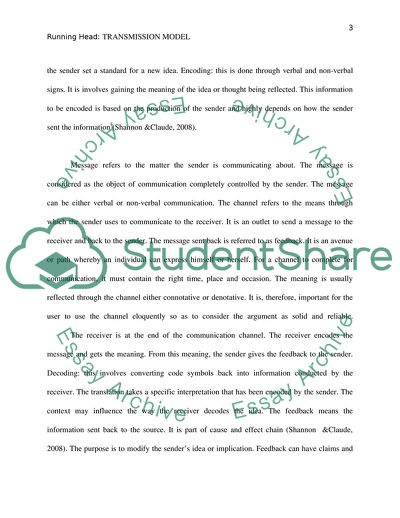Cite this document
(Communication: The Study of Human Interaction Essay Example | Topics and Well Written Essays - 1500 words, n.d.)
Communication: The Study of Human Interaction Essay Example | Topics and Well Written Essays - 1500 words. https://studentshare.org/journalism-communication/1876970-the-transmission-model-of-communication-has-been-heavily-critiqued-from-within-the-reception-or-cultural-context-school-of-thought-which-developed-in-reaction-to-it-despite-this-critique-does-the-transmission-still-provide-the-primary-conceptual-basis-fo
Communication: The Study of Human Interaction Essay Example | Topics and Well Written Essays - 1500 words. https://studentshare.org/journalism-communication/1876970-the-transmission-model-of-communication-has-been-heavily-critiqued-from-within-the-reception-or-cultural-context-school-of-thought-which-developed-in-reaction-to-it-despite-this-critique-does-the-transmission-still-provide-the-primary-conceptual-basis-fo
(Communication: The Study of Human Interaction Essay Example | Topics and Well Written Essays - 1500 Words)
Communication: The Study of Human Interaction Essay Example | Topics and Well Written Essays - 1500 Words. https://studentshare.org/journalism-communication/1876970-the-transmission-model-of-communication-has-been-heavily-critiqued-from-within-the-reception-or-cultural-context-school-of-thought-which-developed-in-reaction-to-it-despite-this-critique-does-the-transmission-still-provide-the-primary-conceptual-basis-fo.
Communication: The Study of Human Interaction Essay Example | Topics and Well Written Essays - 1500 Words. https://studentshare.org/journalism-communication/1876970-the-transmission-model-of-communication-has-been-heavily-critiqued-from-within-the-reception-or-cultural-context-school-of-thought-which-developed-in-reaction-to-it-despite-this-critique-does-the-transmission-still-provide-the-primary-conceptual-basis-fo.
“Communication: The Study of Human Interaction Essay Example | Topics and Well Written Essays - 1500 Words”. https://studentshare.org/journalism-communication/1876970-the-transmission-model-of-communication-has-been-heavily-critiqued-from-within-the-reception-or-cultural-context-school-of-thought-which-developed-in-reaction-to-it-despite-this-critique-does-the-transmission-still-provide-the-primary-conceptual-basis-fo.


